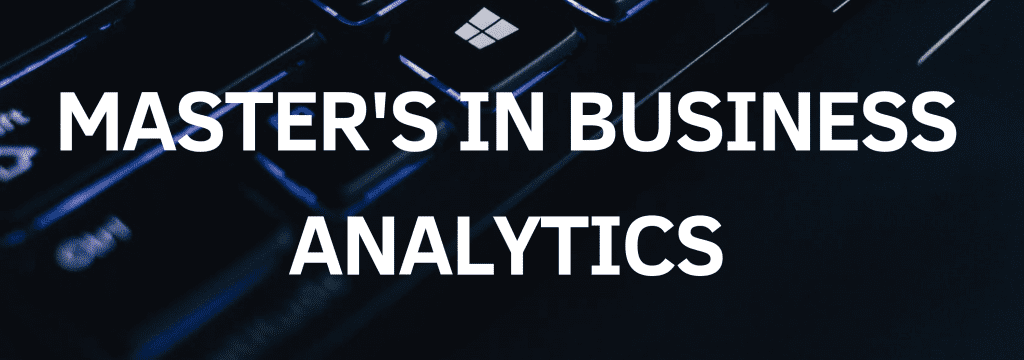A Guide to the Specialized Master’s in Business Analytics

Welcome to MetroMBA’s Master’s in Business Analytics Guide. As the world’s best business schools continue to evolve, traditional MBA programs are being replaced or supplemented with specialized master’s degrees. For many schools, that means including a Master’s in Business Analytics program to provide graduate training specific to careers in financial analysis, statistics, and marketing.
Scroll down to find some of the world’s best Master’s in Business Analytics degrees offered by the world’s leading business schools: a list that continues to grow year by year. But first, what is a Master’s in Business Analytics, what does it take to graduate, and what career opportunities are available after graduation?
What is a Master’s in Business Analytics?
With the rise of big data, businesses are gathering more and more information. Analytics provide a way to understand and effectively put that data to use. Analysts use machine learning algorithms to process data to make conclusions. One of the best-known uses of analytics is Moneyball, the sabermetrics-based system used by many baseball teams since it was first introduced by the Oakland Athletics in 2002.
As analytics find its way into more fields, business analysts can be found across the business landscape, from sports to manufacturing to healthcare to consulting.
The goal of business analysts is to optimize efficiency for the organization, whether it is streamlining the production line or creating a new social media strategy, analytics is making sense of the great amount of data gathered daily in the business world.
Typical Coursework
In all business analytics programs, students will take courses on the following topics:
- Computer programming
- Mathematics (e.g., geometry, calculus, statistics)
- Machine learning
- Visualization
- Optimization
- Analytical techniques
- Modeling
As business analytics graduates inch closer to the professional world, the business- and finance-related courses that come packaged with their programs will help prepare them for their future careers.
Program Accessibility?
The length of the program depends on how one decides to get a Master’s in Business Analytics. The best way for those interested may be through business analytics. The majority of business schools offer business analytics programs that can be completed in 10 to 12 months. In addition, many of these programs are STEM-designated, providing international students with an extra 24 months of optional practical training, providing a total of 36 months.
These programs teach the skills discussed previously and are tailored to prepare students for future careers as business leaders. For example, Duke University’s Fuqua School of Business offers four separate professional tracks—finance, marketing, strategy, and forensics.
There are other programs that offer MBAs with concentrations in business analytics. For example, The Wharton School at the University of Pennsylvania allows students to major in business analytics. Since analytics is only a component of the general program, Wharton students interested in business analytics must complete the two-year MBA program.
Students can complete the program either in person through full-time, part-time, online, or hybrid tracks. The options vary from institution to institution so you will need to decide what is best for you and your career plans.
Typical Cost
As one might expect, it depends on where you complete your program. If you attend a public university, expect to spend more than $60,000 in tuition and fees for the program. This total could be less if you are a resident of the state. If attending a private school, expect to spend around $75,000 in tuition and fees. Neither of these amounts include living expenses such as housing, health care, and transportation.
Career Opportunities
There are many opportunities available in the business sphere for analysts. Most positions have the following names: business analyst, budget analyst, financial analyst, corporate strategy analyst, actuary, social media data analyst, business intelligence analyst, and machine learning analyst. According to the Bureau of Labor Statistics, the median salary for a financial analyst with a master’s degree is $85,660. Experience can increase this amount.
The Top Master’s in Business Analytics Programs

The Sloan School of Management Master’s in Business Analytics at MIT is among the most highly-regarded specialized masters programs in the world. The 12-month MBAn program features 62 current students with an estimated nine months of work experience per enrolled applicant. These students have a typical undergraduate GPA of 3.9, with 40 percent female students and 73 percent international students.
Graduates can expect to earn more than $111,000 USD after earning the MBAn degree, with 100 percent of the most recent graduating class earning employment offers by graduation. Recent MIT Sloan MBAn grads earned roles at firms like McKinsey and Co., Google, Boston Consulting Group (BCG), and Apple, among others.

The Marshall School of Business Master of Science in Business Analytics program at the University of Southern California (USC) is not only a highly-regarded business analytics degree; it’s among the most flexible options out there.
Applicants can choose between a full-time and a part-time option, with those in the full-time track completing their program in just 18 months. Those opting for a part-time track only have to take one course per semester. USC Marshall graduates earning entry-level jobs typically earn between $80-140,000 per year. Those with at least five years of professional experience will see an annual earnings increase to $105-160,000.

The Master of Science in Business Analytics (MSBA) at the University of Minnesota Carlson School of Management is among the highest-ranked analytics programs in the U.S., according to U.S. News & World Report, with 100 percent of graduates earning job offers by the time they earn their degree for three out of the past four years.
MSBA grads from Carlson can expect an average annual salary of $98,205 USD per year, ranging as high as $152,000 per year. More than half (51 percent) of the most recent graduating class earned specific business/data analytics roles at well-known companies like Capital One, Apple, Deloitte, and Facebook, among others.

Among the litany of non-U.S. Master’s in Business Analytics options, few schools manage to stand out quite like the University of Melbourne Business School. The 12-month program focuses on “computer science, statistics, mathematics and business management,” with students learning “SAS, R, Python,” and “Tableau,” among other tools.
Classes typically range between 40-70 students, with 50 on average, ranging from 23-28 years of age. The majority of the most recent class (56 percent) is male, with 44 percent female students, all of which have an average of three-or-less years of work experience.

Purdue University’s Krannert School of Management offers one of the best business analytics programs (specifically its MS Business Analytics and Information Management) in the Midwest U.S., giving business school students a unique opportunity to focus on studies in a more STEM-oriented curriculum. The full-time program is also only 11 months long, making it one of the most time-efficient master’s programs in U.S., in addition to being one of the most affordable. In-state students only pay a tuition rate of $24,000 USD, with out-of-state students only due $34,200.
MS BAIM grads from Krannert earn a typical employment rate of 94 percent with an average annual salary of $81,320 and an average signing bonus of $10,131. Several previous employers of MS BAIM grads include Amazon, NBC Universal, and Discover Financial Services, among others.
 Loading Programs
Loading Programs
